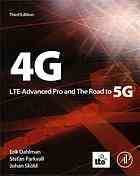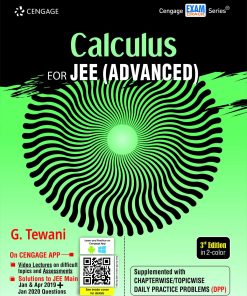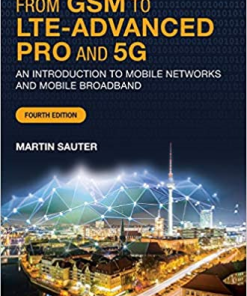4G, LTE-advanced pro and the road to 5G 3rd Edition by Erik Dahlman, Stefan Parkvall, Johan Skold 0128046111 9780128046111
$50.00 Original price was: $50.00.$25.00Current price is: $25.00.
4G, LTE-advanced pro and the road to 5G 3rd Edition by Erik Dahlman, Stefan Parkvall, Johan Skold – Ebook PDF Instant Download/DeliveryISBN: 0128046111, 9780128046111
Full download 4G, LTE-advanced pro and the road to 5G 3rd Edition after payment.

Product details:
ISBN-10 : 0128046111
ISBN-13 : 9780128046111
Author: Erik Dahlman, Stefan Parkvall, Johan Skold
The upcoming 5G specifications from 3GPP, to be available in 2018, will include LTE-Advanced Pro as well as a new 5G radio-access technology. This practical and very successful book, written by engineers working closely with 3GPP, gives insight into the newest technologies and standards adopted by 3GPP, with detailed explanations of the specific solutions chosen and their implementation in LTE, LTE-Advanced, and LTE-Advanced Pro, as well as providing a detailed description of the path to 5G and the associated underlying technologies.
4G, LTE-advanced pro and the road to 5G 3rd Table of contents:
Chapter 1. Introduction
1.1. 1G and 2G—Voice-Centric Technologies
1.2. 3G and 4G—Mobile Broadband
1.3. 5G—Beyond Mobile Broadband—Networked Society
1.4. Outline
Chapter 2. Spectrum Regulation and Standardization From 3G to 5G
2.1. Overview of Standardization and Regulation
2.2. ITU-R Activities From 3G to 5G
2.3. Spectrum for Mobile Systems
2.4. Spectrum for 5G
2.5. 3GPP Standardization
Chapter 3. LTE Radio Access: An Overview
3.1. LTE Basic Technologies
3.2. LTE Evolution
3.3. Spectrum Flexibility
3.4. Multi-Antenna Enhancements
3.5. Densification, Small Cells, and Heterogeneous Deployments
3.6. Device Enhancements
3.7. New Scenarios
3.8. Device Capabilities
Chapter 4. Radio-Interface Architecture
4.1. Overall System Architecture
4.2. Radio Protocol Architecture
4.3. Control-Plane Protocols
Chapter 5. Physical Transmission Resources
5.1. Overall Time–Frequency Structure
5.2. Normal Subframes and MBSFN Subframes
5.3. Antenna Ports
5.4. Duplex Schemes
5.5. Carrier Aggregation
5.6. Frequency-Domain Location of LTE Carriers
Chapter 6. Downlink Physical-Layer Processing
6.1. Transport-Channel Processing
6.2. Downlink Reference Signals
6.3. Multi-Antenna Transmission
6.4. Downlink L1/L2 Control Signaling
Chapter 7. Uplink Physical-Layer Processing
7.1. Transport-Channel Processing
7.2. Uplink Reference Signals
7.3. Uplink Multi-Antenna Transmission
7.4. Uplink L1/L2 Control Signaling
7.5. Uplink Power Control
7.6. Uplink Timing Alignment
Chapter 8. Retransmission Protocols
8.1. Hybrid ARQ with Soft Combining
8.2. Radio-Link Control
Chapter 9. Scheduling and Rate Adaptation
9.1. Scheduling Strategies
9.2. Downlink Scheduling
9.3. Uplink Scheduling
9.4. Timing of Scheduling Assignments/Grants
9.5. Semi-Persistent Scheduling
9.6. Scheduling for Half-Duplex FDD
9.7. Discontinuous Reception
Chapter 10. Channel-State Information and Full-Dimension MIMO
10.1. CSI Reports
10.2. Periodic and Aperiodic CSI Reports
10.3. Interference Estimation
10.4. Channel-Quality Indicator
10.5. Rank Indicator and Precoder Matrix Indicator
10.6. Full-Dimension MIMO
Chapter 11. Access Procedures
11.1. Acquisition and Cell Search
11.2. System Information
11.3. Random Access
11.4. Paging
Chapter 12. Carrier Aggregation
12.1. Overall Protocol Structure
12.2. Primary and Secondary Component Carriers
12.3. Self-Scheduling and Cross-Carrier Scheduling
12.4. DRX and Component-Carrier Deactivation
12.5. Downlink Control Signaling
12.6. Uplink Control Signaling
12.7. Timing Advance and Carrier Aggregation
Chapter 13. Multi-Point Coordination and Transmission
13.1. Inter-Cell Interference Coordination
13.2. Multi-Point Coordination/Transmission
Chapter 14. Heterogeneous Deployments
14.1. Interference Scenarios in Heterogeneous Deployments
14.2. Heterogeneous Deployments Using Rel-8 Functionality
14.3. Frequency-Domain Partitioning
14.4. Time-Domain Partitioning
14.5. Shared Cell
14.6. Closed Subscriber Groups
Chapter 15. Small-Cell Enhancements and Dynamic TDD
15.1. Small-Cell On/Off
15.2. Dynamic TDD and eIMTA
Chapter 16. Dual Connectivity
16.1. Architecture
16.2. Physical-Layer Impact
16.3. Scheduling in Dual Connectivity
Chapter 17. Unlicensed Spectrum and License-Assisted Access
17.1. Spectrum for LAA
17.2. Wi-Fi Basics
17.3. Technology Components for LAA
17.4. Enhancements Beyond Release 13
Chapter 18. Relaying
18.1. Relays in LTE
18.2. Overall Architecture
18.3. Backhaul Design for Inband Relaying
Chapter 19. Multimedia Broadcast/Multicast Services
19.1. Architecture
19.2. MBSFN Channel Structure and Physical-Layer Processing
19.3. Scheduling of MBSFN Services
19.4. Single-Cell Point to Multipoint Transmission
Chapter 20. LTE for Massive MTC Applications
20.1. Introduction
20.2. MTC Enhancements for LTE Release 12
20.3. MTC Enhancements for LTE Release 13: eMTC
20.4. Narrow-Band Internet of Things
Chapter 21. Device-to-Device Connectivity
21.1. Overview
21.2. Sidelink Communication
21.3. Sidelink Discovery
21.4. Sidelink Synchronization
21.5. Device-to-Device Extensions in LTE Release 13
Chapter 22. Spectrum and RF Characteristics
22.1. Flexible Spectrum Use
22.2. Flexible Channel Bandwidth Operation
22.3. Carrier Aggregation for LTE
22.4. Operation in Noncontiguous Spectrum
22.5. Multi-Standard Radio Base Stations
22.6. Overview of RF Requirements for LTE
22.7. Output Power Level Requirements
22.8. Transmitted Signal Quality
22.9. Unwanted Emissions Requirements
22.10. Sensitivity and Dynamic Range
22.11. Receiver Susceptibility to Interfering Signals
22.12. Multiband-Capable Base Stations
22.13. RF Requirements for Relays
22.14. RF Requirements for License-Assisted Access
22.15. RF Requirements for BS with Active Antenna Systems
Chapter 23. 5G Wireless Access
23.1. What Is 5G?
23.2. 5G and IMT-2020
23.3. One Versus Multiple Technologies: “Network Slicing”
23.4. 5G Spectrum
23.5. LTE Evolution Versus New 5G Technology
23.6. Frequency Bands for 5G Initial Deployments
23.7. 5G Technical Specification
Chapter 24. New 5G Radio-Access Technology
24.1. 5G: Some General Design Principles
24.2. 5G: Key Technology Components
Chapter 25. Concluding Remarks
People also search for 4G, LTE-advanced pro and the road to 5G 3rd:
4g lte-advanced pro and the road to 5g pdf
lte advanced vs 5g
4g lte advanced pro
from lte to lte-advanced pro and 5g
lte advanced pro
Tags: advanced pro, the road, Erik Dahlman, Stefan Parkvall, Johan Skold
You may also like…
Computers - Programming
Pro Bash: Learn to Script and Program the GNU/Linux Shell 3rd Edition Jayant Varma
Business & Economics - Others
Complete Economics for Cambridge IGCSE (R) and O Level 3rd Revised edition Edition Titley
Uncategorized
Mathematics - Others
Computers - Cryptography
Computers - Cryptography












